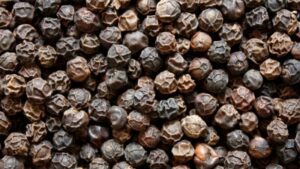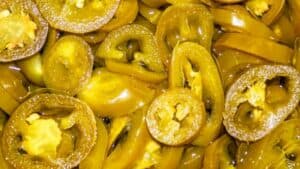As a
Luckily, there are some easy techniques to decipher distinct pepper types. By looking for visual cues, tasting carefully, and referencing plant characteristics, you can become an expert pepper identifier in no time.
First, pay attention to the pepper’s shape and color when ripe. For example, jalapeños are typically elongated and turn red, while habaneros are small, wrinkled, and orange. Check the heat level too, from sweet bell peppers to fiery habaneros.
Next, take a sniff and little taste of the inner pepper flesh. Each variety has unique aromas and flavors. Chipotles are smoky, while habaneros are citrusy.
If you can examine the entire plant, the flowers, leaves, stems, and growth habits provide definitive proof of the pepper type. Habaneros have tiny curved flowers buds and smooth leaves, for instance.
Finally, consult online guides or books with detailed photos to confirm the exact species based on all the characteristics. Cross-check your specimen against multiple visual references.
With these insider tips, you’ll be able to readily identify peppers at markets or in your own garden plots. Check out the full article for more tips on how to become a pepper pro through sight, smell, taste, and research. Soon you’ll intuitively recognize all your spicy favorites!
Observe the Color and Shape
The most obvious identifiers are the color and shape of the pepper. While green is the default immature color, many turn shades of red, orange, yellow, purple, brown, or even black when ripe. Shape can be long and skinny, short and round, blocky, wrinkled, curved, or bulbous.
For example, jalapeños are typically dark green transitioning to red. They have a smooth, elongated shape that tapers to a rounded tip. Habaneros are light green ripening to orange or red. They have a distinctive wrinkled, lantern-like shape.
Shape and color combinations offer good initial clues, which you can then verify with other characteristics.
Check the Heat Level
Peppers exist on a spicy spectrum from mild and sweet to searingly hot. The heat sensation comes from a chemical compound called capsaicin. The concentration of capsaicin is measured in Scoville Heat Units.
On the lower end, bell peppers and poblanos register 0-1,000 SHU. In the middle are peppers like jalapeños at 2,500-10,000 SHU. Habaneros are blazing hot at 100,000-350,000 SHU. Identifying the intensity of flavor provides useful insight on the type.
Smell and Taste the Pepper
Crush a small piece of the pepper and sniff it. Then cautiously taste a tiny bit. The unique aromas and flavors of each pepper species are very telling.
For example, habaneros have a fruity, citrusy smell and flavor. Jalapeños give off a vegetal, grassy vibe. Chipotles are smoky. Pay close attention to the sensory profile.
Examine the Plant Parts
Viewing the entire pepper plant can provide definitive proof of its type. Look at the flowers, leaves, stems, and overall growth habit.
Pepper flowers have small white or purple corollas. Leaves come in many shapes and textures. Habaneros have tiny curved flower buds and smooth, pointed leaves. Jalapeños have larger white flowers and coarsely textured ovate leaves.
Identifying Peppers by Their Leaves
The leaves growing on a pepper plant can provide valuable clues to help identify the exact variety. Here’s what to look for:
- Leaf shape – Pepper leaves come in many forms like ovate, lanceolate, deltate, or filiform. Shape can indicate the type.
- Leaf margins – Edges may be entire, dentate, serrated, or wavy. Jalapeño leaves have finely serrated edges.
- Leaf texture – Leaves may be smooth, wrinkled, or bumpy. Bell peppers have very smooth leaves.
- Leaf color – Ranges from light to dark green, purple, grayish, etc. Habanero leaves are pale green.
- Leaf veins – Vein patterns, particularly the central vein, differ among varieties.
- Leaf size – Leaf length and width can hint at the pepper type. Chili pepper leaves tend to be smaller.
- Scent – Crush a leaf and sniff. Scent profiles may match the fruit aroma.
Comparing the leaf characteristics to reference guides makes accurate identification easier. So don’t just look at the pepper itself – check the foliage too!
Identifying Peppers in Cooked Dishes
It can be tricky to identify the type of peppers used in prepared foods, salsas, and cooked dishes where you can’t see the whole fruit. Here are some tips:
- Look for flecks of characteristic skin and flesh colors – green, red, orange, yellow.
- Check for seeds and internal membranes which may remain partially intact.
- Taste carefully and pay attention to flavor nuances – smoky chipotle, sweet bell pepper, tangy jalapeño.
- Note the
spice level on your palate – a big clue to whether mild or hot peppers were used. - Smell for distinguishable scents like garlic, vinegar, or cilantro that often season certain pepper varieties.
- Study the cuisine’s flavor profile – some prefer spicier peppers over others.
- Ask the cook directly if possible to ID the exact types used.
Consult Identification Guides
For full accuracy, turn to reference guides with photos of the fruit, flowers, leaves, and growing habits of different pepper varieties. Many excellent books and online resources exist to help you positively identify the exact species.
Cross-check your specimen against multiple visual aides. With experience, you’ll start intuitively recognizing key pepper varieties.
Top Tips for Identification
Follow this checklist when attempting to identify unknown peppers:
- Note the color and shape.
- Consider the heat level through tasting.
- Smell the inner pepper flesh.
- Inspect the foliage and flowers if available.
- Thoroughly compare to guides for positive ID.
Now put your pepper sleuthing skills to work! Confidently choose the perfect varieties for your recipes and gardens. Happy identifying!





